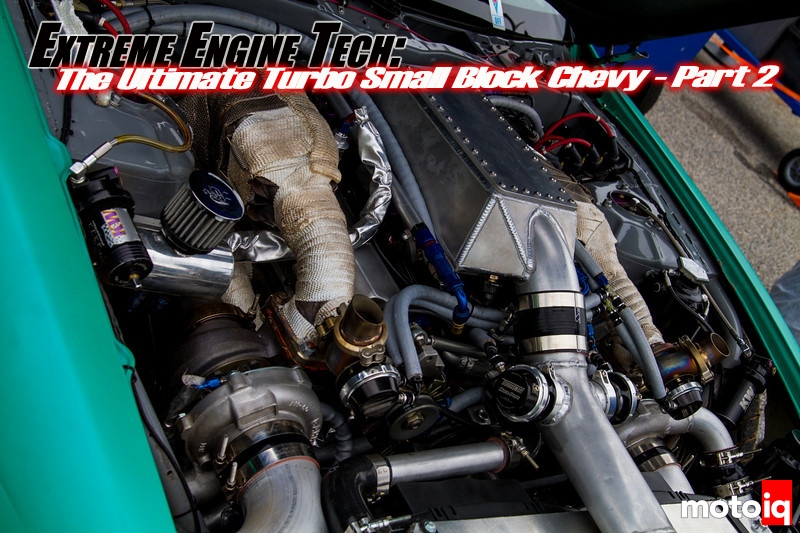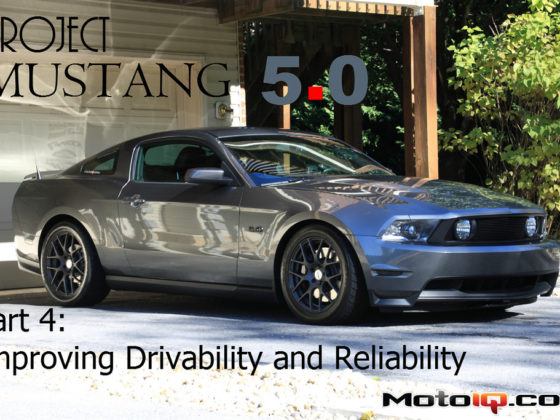Building the Ultimate Turbo Small Block Chevy Part 2, The Making of 1100 Hp!
When deciding the best way to power Daren McNamara’s Formula D S14, Team Falken decided to plow into new territory with not just a turbo, but a turbo V8. Not your typical Chevy LS V8 either, but a blast from the past old school Small Block Chevy. In our last edition of building the ultimate Small Bock Chevy, we looked into the developments that had been made to the venerable 60 year old design to update it to modern standards, particularly the bottom end. In short, the improvements were mostly moving the cam upward to allow for more stroke and to shorten the pushrods for less flex, and a general beefing up of the lower end architecture to support today’s power levels.
In this edition we will get into more of the interesting tricks done to the good old Small Block to keep it relevant and even better in some respects to the newer LS engines. In the tough world of Formula D competition, light weight, high power density and bulletproof reliability are all critical. Will Team Falken’s unique creation propel Darren McNamara to the podium? Check it out.
Part one of the building of the Ultimate Turbo Small Block.
For More Information on the rest of Team Falken’s super S14 check this out!
 The bottom end is assembled with the Brian Crower H11 tool steel rod bolts torqued by the stretch method. The ARP studs holding the main caps down are torqued by the angle method. This ensures proper tightening independent of friction between the fastener threads. The bottom end is now ready for the unique oil pan. Although not shown, crankshaft torsional whip is controlled by a Fluidampr harmonic balancer. The Fluidampr is unique as it is amplitude sensitive, not frequency sensitive so it damps the most when it is needed most. We have had a lot of luck with Fluidamprs on our own builds.
The bottom end is assembled with the Brian Crower H11 tool steel rod bolts torqued by the stretch method. The ARP studs holding the main caps down are torqued by the angle method. This ensures proper tightening independent of friction between the fastener threads. The bottom end is now ready for the unique oil pan. Although not shown, crankshaft torsional whip is controlled by a Fluidampr harmonic balancer. The Fluidampr is unique as it is amplitude sensitive, not frequency sensitive so it damps the most when it is needed most. We have had a lot of luck with Fluidamprs on our own builds. The Dailey Engineering oil pan is CNC machined from a solid block of billet aluminum and is pretty thick. You might wonder why a thick and seemingly heavy oil pan is a good thing. The reason for this is that the Small Block is a low rail design. In the 50’s this was haled as an innovative way to make an engine lighter but as power levels rose, the wide open bottom end was not as stiff and strong as modern designs with deep cross boiled pan rails and bed pates. Problem with main caps walking and crank bearings arose due to lack of bottom end structure. Although the Dart block has more material around the rails and main caps, is is significantly stiffened by the thick billet pan that ties the bottom end together. The pan is actually a part of the blocks structural system.
The Dailey Engineering oil pan is CNC machined from a solid block of billet aluminum and is pretty thick. You might wonder why a thick and seemingly heavy oil pan is a good thing. The reason for this is that the Small Block is a low rail design. In the 50’s this was haled as an innovative way to make an engine lighter but as power levels rose, the wide open bottom end was not as stiff and strong as modern designs with deep cross boiled pan rails and bed pates. Problem with main caps walking and crank bearings arose due to lack of bottom end structure. Although the Dart block has more material around the rails and main caps, is is significantly stiffened by the thick billet pan that ties the bottom end together. The pan is actually a part of the blocks structural system. These internal buttresses help further stiffen the pan without increasing windage losses.
These internal buttresses help further stiffen the pan without increasing windage losses. The Dailey Engineering 5 stage dry sump pump bolts right to the pan itself. Pro Drift cars are becoming quite developed and the top cars pull so many lateral G’s that it is impossible to keep them lubed with a conventional wet sump system, even with baffled pans and accusumps. This baffle helps strip the windage cloud off the crank and direct it to each of the 4 pump stages evacuating the pan.
The Dailey Engineering 5 stage dry sump pump bolts right to the pan itself. Pro Drift cars are becoming quite developed and the top cars pull so many lateral G’s that it is impossible to keep them lubed with a conventional wet sump system, even with baffled pans and accusumps. This baffle helps strip the windage cloud off the crank and direct it to each of the 4 pump stages evacuating the pan.



